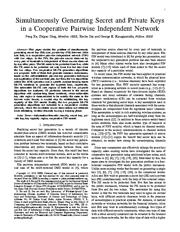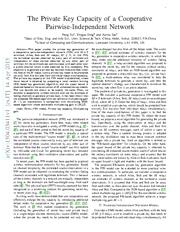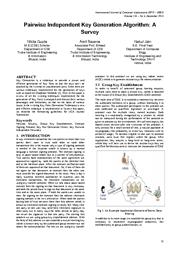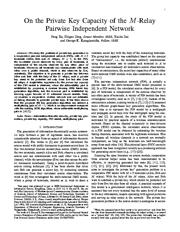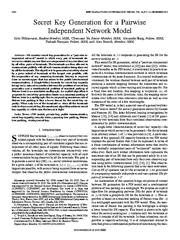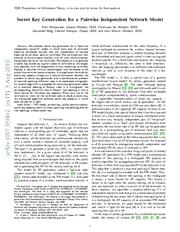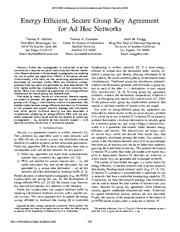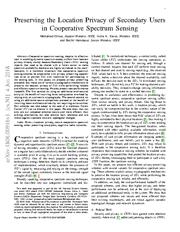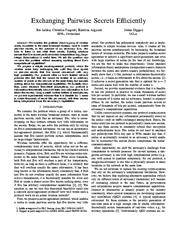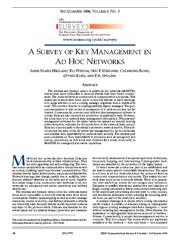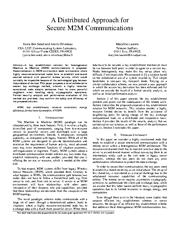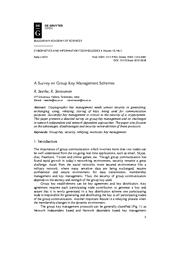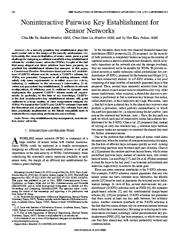A copy of this work was available on the public web and has been preserved in the Wayback Machine. The capture dates from 2019; you can also visit the original URL.
The file type is application/pdf.
Filters
Simultaneously Generating Secret and Private Keys in a Cooperative Pairwise-Independent Network
2016
IEEE Transactions on Information Forensics and Security
This paper studies the problem of simultaneously generating secret key (SK) and private key (PK) between Alice and Bob, in a cooperative pairwise independent network (PIN) with two relays. ...
Two cooperative SK-PK generation algorithms are proposed: both of them first generate common randomness, based on the well-established pairwise key generation technique and application of the one-time ...
Using these pairwise keys, the SK-PK generation scheme in Algorithms 1 and 2 can be utilized to simultaneously generate the secret key and private key shared by Alice and Bob. ...
doi:10.1109/tifs.2016.2516970
fatcat:uqhwdg2ypbg5lcbgadkno7xyra
The Private Key Capacity of a Cooperative Pairwise-Independent Network
[article]
2015
arXiv
pre-print
This paper studies the private key generation of a cooperative pairwise-independent network (PIN) with M+2 terminals (Alice, Bob and M relays), M >= 2. ...
Then, we consider a cooperative wireless network and use the estimates of fading channels to generate private keys. ...
ACKNOWLEDGEMENTS The work of Peng Xu and Xuchu Dai was supported by the National Natural Science Foundation of China (NSFC) under grant number 61471334. ...
arXiv:1504.03411v1
fatcat:icsl4m457zg4hetegap3ool2lu
Pairwise Independent Key Generation Algorithm: A Survey
2016
International Journal of Computer Applications
Key Generation is a technique to provide a secure and efficient generation of Key Pairs so that the keys can't be attacked by the external or unauthorized users. ...
Since there are various techniques implemented for the generation of keys such as based on Graphical Methods [ ...
High Storage
Cost and
Inefficient key
generation.
4.
The private Key Capacity of a
Cooperative Pairwise-
Independent Network.
High storage
capacity for
secrete keys is
required.
5. ...
doi:10.5120/ijca2016912468
fatcat:lelhbtthuvagzhwqcysl5nyuwu
On the private key capacity of the M-Relay pairwise independent network
2016
Zenodo
We study the problem of private key generation in a cooperative pairwise independent network (PIN), with M + 2 terminals (Alice, Bob, and M relays), M ≥ 2. ...
Next, we consider a cooperative wireless network and use the estimates of fading channels to generate private keys. ...
A PAIRWISE INDEPENDENT NETWORK Consider a cooperative DMS model with M + 2 terminals (Alice, Bob and M relays, M ≥ 2) and a passive eavesdropper (Eve). ...
doi:10.5281/zenodo.3690793
fatcat:aavhonurazbkjhsvm36jcwj5qe
Secret Key Generation for a Pairwise Independent Network Model
2010
IEEE Transactions on Information Theory
We consider secret key generation for a "pairwise independent network" model in which every pair of terminals observes correlated sources that are independent of sources observed by all other pairs of ...
A (single-letter) formula for secret key capacity brings out a natural connection between the problem of secret key generation and a combinatorial problem of maximal packing of Steiner trees in an associated ...
This model for SK generation, called a "pairwise independent network" model, was introduced in [23] (see also [22] ). ...
doi:10.1109/tit.2010.2081210
fatcat:usju27xfmjgfnauncf336qprge
Secret key generation for a pairwise independent network model
2008
2008 IEEE International Symposium on Information Theory
We consider secret key generation for a "pairwise independent network" model in which every pair of terminals observes correlated sources that are independent of sources observed by all other pairs of ...
A (single-letter) formula for secret key capacity brings out a natural connection between the problem of secret key generation and a combinatorial problem of maximal packing of Steiner trees in an associated ...
This model for SK generation, called a "pairwise independent network" model, was introduced in [23] (see also [22] ). ...
doi:10.1109/isit.2008.4595140
dblp:conf/isit/NitinawaratYBNR08
fatcat:n2pikexk3vhbficic7sz37rhsi
Secret Key Generation for a Pairwise Independent Network Model
[article]
2010
arXiv
pre-print
We consider secret key generation for a "pairwise independent network" model in which every pair of terminals observes correlated sources that are independent of sources observed by all other pairs of ...
A (single-letter) formula for secret key capacity brings out a natural connection between the problem of secret key generation and a combinatorial problem of maximal packing of Steiner trees in an associated ...
This model for SK generation, called a "pairwise independent network" model, was introduced in [23 ] (see also [22] ). ...
arXiv:1007.3518v2
fatcat:4jcosib64jhevij5ymu2sehqca
Energy-efficient, secure group key agreement for ad hoc networks
2013
2013 IEEE Conference on Communications and Network Security (CNS)
Unfortunately, while many ad hoc networking applications are dominated by multicast traffic, PKAs are inherently unicast: public/private key pairs are generated by data destinations. ...
Public key cryptography is well-suited to ad hoc networks as it requires no a priori secure key distribution mechanism. ...
Protocol Specification Given an n node network, a total of n 2 pairwise cryptographic master keys are generated and distributed to the network nodes such that each pairwise key is shared by exactly two ...
doi:10.1109/cns.2013.6682706
dblp:conf/cns/HalfordCC13
fatcat:2yelk3fcwffz7fg4sgeq3ljcpe
Preserving the Location Privacy of Secondary Users in Cooperative Spectrum Sensing
2017
IEEE Transactions on Information Forensics and Security
Our schemes can also adapt to the case of a malicious fusion center as we discuss in this paper. ...
We also show that not only are our proposed schemes secure and more efficient than existing alternatives, but also achieve fault tolerance and are robust against sporadic network topological changes. ...
(ii) It cannot handle dynamism if multiple users join or leave the network simultaneously. (iii) The pairwise secret sharing requirement incurs extra communication overhead and delay. ...
doi:10.1109/tifs.2016.2622000
fatcat:i37wj3nnsjg7bi6i3yf2wuonqe
Exchanging pairwise secrets efficiently
2013
2013 Proceedings IEEE INFOCOM
We consider the problem where a group of wireless nodes, connected to the same broadcast domain, want to create pairwise secrets, in the presence of an adversary Eve, who tries to listen in and steal these ...
We propose a simple secret-agreement protocol, where the wireless nodes keep exchanging bits until they have agreed on pairwise secrets that Eve cannot reconstruct with very high probability. ...
Also, it creates all the pairwise secrets simultaneously by harnessing the broadcast nature of wireless networks. ...
doi:10.1109/infcom.2013.6567030
dblp:conf/infocom/SafakaFAD13
fatcat:dbwypcqqvbe3dfb7lh4eiv4i2e
A survey of key management in ad hoc networks
2006
IEEE Communications Surveys and Tutorials
The general assumption is that nodes in possession of a valid secret key can be trusted. Consequently, a secure and efficient key-management scheme is crucial. ...
Keys are a prerequisite to bootstrap a protected network service. ...
We also thank Leif Nilsen of the Univeristy of Oslo's University Graduate Centre/Thales Group Norway for valuable discussions and comments on our work. A special thanks to Prof. ...
doi:10.1109/comst.2006.253271
fatcat:zaobvvfiqzc2jovl7rozpplhxa
A Distributed Approach for Secure M2M Communications
2012
2012 5th International Conference on New Technologies, Mobility and Security (NTMS)
A key establishment solution for heterogeneous Machine to Machine (M2M) communications is proposed. ...
This paper proposes a novel collaborative session key exchange method, wherein a highly resourceconstrained node obtains assistance from its more powerful neighbors when handling costly cryptographic operations ...
that owns a shared secret with all nodes in the sensor network and a public/private key pair. ...
doi:10.1109/ntms.2012.6208702
dblp:conf/ntms/SaiedOL12
fatcat:5h5vrrxdize6boosryxehj7fpq
A Survey on Group Key Management Schemes
2015
Cybernetics and Information Technologies
This paper presents a detailed survey on group key management and its challenges in network independent and network dependent approaches. ...
Cryptographic key management needs utmost security in generating, exchanging, using, rekeying, storing of keys, being used for communication purposes. ...
Conclusion The paper discusses various approaches of group key management both in network independent environment and network independent environment. ...
doi:10.1515/cait-2015-0038
fatcat:qhbtuqohyfd4hooxvixqouz6iy
A Simple Non-Interactive Pairwise Key Establishment Scheme in Sensor Networks
2009
2009 6th Annual IEEE Communications Society Conference on Sensor, Mesh and Ad Hoc Communications and Networks
In this paper, a ConstrAined Random Perturbation-based pairwise keY establishment (CARPY) scheme and its variant, a CARPY+ scheme, for WSNs, are presented. ...
Unfortunately, the resource limitation of sensor nodes poses a great challenge for designing an efficient and effective key establishment scheme for wireless sensor networks (WSNs). ...
ACKNOWLEDGMENT Preliminary versions of portions of this paper were presented in [32] and [35] . ...
doi:10.1109/sahcn.2009.5168906
dblp:conf/secon/YuLK09
fatcat:w46zlk7juzhyhlt2gee6kal4z4
Noninteractive Pairwise Key Establishment for Sensor Networks
2010
IEEE Transactions on Information Forensics and Security
In this paper, a ConstrAined Random Perturbation-based pairwise keY establishment (CARPY) scheme and its variant, a CARPY+ scheme, for WSNs, are presented. ...
Unfortunately, the resource limitation of sensor nodes poses a great challenge for designing an efficient and effective key establishment scheme for wireless sensor networks (WSNs). ...
ACKNOWLEDGMENT Preliminary versions of portions of this paper were presented in [32] and [35] . ...
doi:10.1109/tifs.2010.2050140
fatcat:uvrxvoms3zhjhemxyf4ltdkp54
« Previous
Showing results 1 — 15 out of 1,613 results

